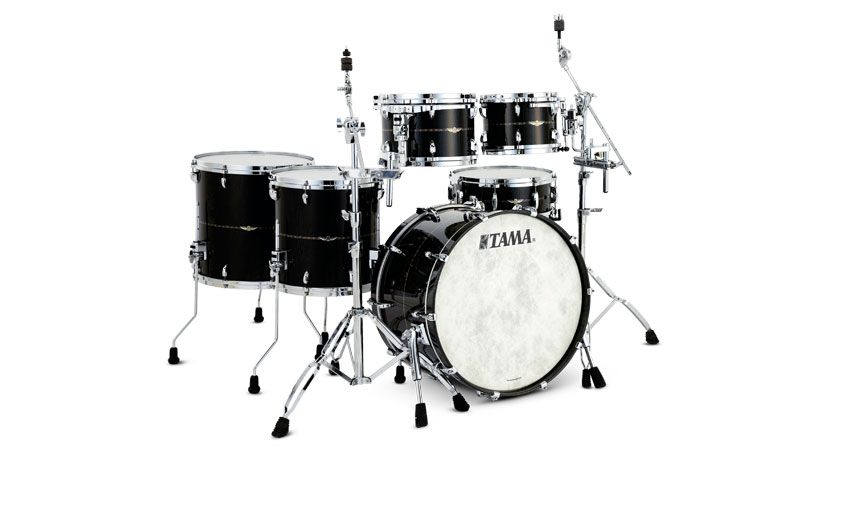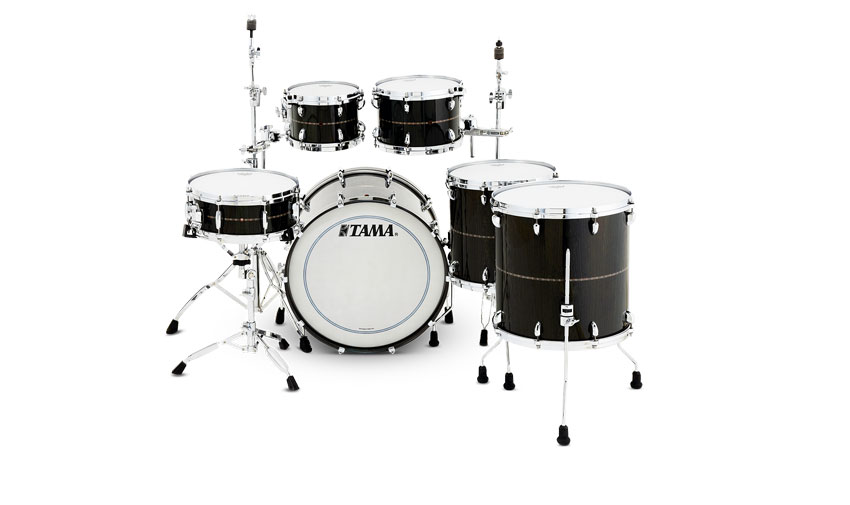MusicRadar Verdict
Two grand for a bass drum is scary. But Tama has gone to great lengths to achieve its goal of maximum shell resonance and woody tone via a series of ingenious solutions which call on the old and the new.
Pros
- +
Superb construction, looks and tones.
Cons
- -
Devastating price!
MusicRadar's got your back

Tama Star Bubinga kit review

Rear
Tama's erstwhile flagship Starclassic has been around for 20 years, so you might say the Star series is overdue. Tama has restricted the Star options to two major wood types - bubinga and maple. Bubinga has become a surprise drum hit and Tama was the first big company to use it. It's that kit we're looking at here.
Having learned much during the Starclassic years, Tama reveals that the primary goal with the Star was to re- examine every detail "to enhance shell resonance". This has led to some interesting solutions and surprising retro features, as we shall see.
Build
We have a full bubinga kit, finished in Dark Green Cordia and consisting of a 22"x14" bass drum, 10"x7" and 12"x8" mounted toms, 14"x14" and 16"x16" floor toms with matching 14"x51⁄2" snare. The finish is sensational and the bottle green gloss lacquer looks and feels glorious.
Interestingly Tama has opted for vintage-style extra-thin shells with Sound Focus (reinforcing) Rings. The bubinga is 4.5mm with a single inner ply of Cordia plus a 9mm SFR. (Heftier Starclassic bubinga shells were non-reinforced and 9mm thick.)
"Bearing edges are painstakingly cut, perfectly level and hand-finished with oil"
The review drums have the attractive inlay feature previously seen on the Starclassic bubinga. There are three options - the standard being for an inlay around each drum's circumference. But you can also have the inlay on the inside, around the Sound Focus Rings. Or simply have no inlay at all. The inlay, by the way, incorporates the Star winged logo badge. No resonance-killing metal badges for these babies - even the air holes are wood (not metal) grommets.
Removing heads reveals the bubinga shells have a vertically-laid single veneer of cordia wood with its striking stripy dark chocolate grain. Another nod in the vintage direction sees Tama rounding off its bearing edges (unlike the sharp edges of modern drums), allowing broader contact between the head and shell. And there is also a substantial outer cut so that the edge peaks 3.5mm in, further towards the centre of the drum than usual. This also increases head-to-shell contact.
Bearing edges are painstakingly cut, perfectly level and hand-finished with oil. Not all the ruses designed to extract maximum resonance are vintage. While the supported shells have a classic vibe, the metal work is in keeping with Tama's impressive record at the forefront of hardware design. Toms and bass drum have a new cast lug, a bridged design for minimal shell contact with an attractive curvy shape and four-faced ridges. Hoops are die-cast zinc, more consistent and structurally solid than triple-flangers. And aiding the hoops are Hold Tight washers, which have a stainless steel cup containing a rubber ring. This prevents de-tuning under modern heavy playing.
"When it comes to tom mounting technology we have come a long way from earlier crude designs"
Likewise, when it comes to tom mounting technology we have come a long way from earlier crude designs. With the aim always to reduce stress and enhance resonance, Tama's Super Resonant Mounting System is innovative and clever. Most isolation mounts attach to the upper lugs of the tom, which inevitably puts stress on the tuning bolts and lugs. So Tama has radically re-designed the die-cast batter hoop to avoid this by including additional ears for mounting, extra to the normal ears through which you slip the tension rods. The three-point mount system has two outer points on the batter hoop, which float on rubber sleeves and support the vertical weight of the drum.
A third, central point leans against the lower hoop at the end of a vertical support arm. If the drum is mounted at a severe angle, the top end of this arm comes into play, which is slotted inside a third, central, ear on the batter hoop. Either way, Tama claims that this new design takes considerable stress off the shell.
Both mounted and floor toms also incorporate Tama's second smart innovation, called Quick Lock, which is a combined memory lock and mounting bracket. The memory lock section stays attached to the floor tom leg or the tom bracket arm, secured by the usual wing nut, at your chosen height and angle. Setting up or breaking down, you simply slot this into the suspension mount housing where it is locked in place by a black nylon ring switch.
Tama suggests bass drum spurs fulfil a broadly similar function to floor tom legs. In connecting the drum with the floor and simultaneously stabilising it, the shell's energy can again be compromised. Tama's boffins reasoned that, just as floor tom legs need to be isolated from the tom shell, so should spurs.
Accordingly, Tama has split each spur into two sections separated by a rubber shock absorber so that the forward movement of the drum as you kick your pedal is absorbed by the rubber and the drum's energy is not dissipated into the floor.
Moving on to the snare drum, this also has not escaped the withering eye of Tama's resonance sleuths. There's a new one-piece double-ended bridge lug and there are eight rather than 10 of them, again lightening the load.
Meanwhile, the Linear-Drive snare strainer is a joy. The throw-off is isolated from the shell and on both the strainer and butt sides the strings are brought up at an angle. The linear lever itself has a smart action which locks past the vertical point. The piston tension knob has position clicks so it can't come loose.
Hands On
We braved taking out the bubinga snare on a gig and we're so glad we did. A wide-eyed drumming mate came straight up to say it sounded great. Tama suggests that bubinga has a deep rich tone while the traditional maple is bright and open. We'd echo that to an extent, but whatever, the bubinga snare just sounded crackin' - clean, edgy, fat, warm... expensive!
We couldn't take a whole kit out for a live thrashing, so we decided to ask Rhythm friend Kenny Aronoff how he finds bubinga and maple differ. Kenny has recorded with both woods probably more than anyone. "Bubinga is a harder, denser wood and has a little more punch or attack, more low-end," he asserts. "I would say maple drums are a bit warmer. When I do sessions, they both work equally well. But if I want a little more aggressive sound, I use bubinga."
Back home we noticed the dark side of the bubinga sound with the bass drum. It's a subtle thing though. The retro vibe is properly respected in the 14"-deep bass drum and, being shallow, it responded quickly with a great slam. If you want that classic immediate sound - from Al Jackson to John Bonham to Tama's own funky John Blackwell -you need a 14" deep bass. They look cool too and are easier to transport.
Overall, the drums offer an astute combination - thin shells which promote resonance of the respective woody timbres and bring out the deeper fundamentals, coupled with Sound Focus Rings which channel the attack.
Rounded edges that mean more of the shell is in contact with the head, allowing the shell tone to make more impact, warming the tone, slightly mollifying the attack and controlling the sustain. But then along come the aggressive die-cast hoops to give stability and make tuning especially easy.
The snares sits perfectly, tonally, with the kits. The Linear-Drive strainer is smooth and silent in action. The usual dip of Tama's snappy snare beds has been levelled out to the extent that so far as we can see there are no snare beds. And it would seem to make no difference, the drums work perfectly.
“This update reflects everything we believe modern gear should be”: Neural DSP gives the Nano Cortex an almighty power-up with free NanOS 2.0.0 system update
“It’s honestly got me thinking hard about adding one to my own studio set up”: Two Notes Reload II review
“Gloriously adorned with a gold edge burst finish over a gold paisley and sparkle top”: Gretsch unveils the Paisley Penguin – a rare bird that growls – and the Honey Dipper Special, a resonator for all your roots rock manoeuvres









